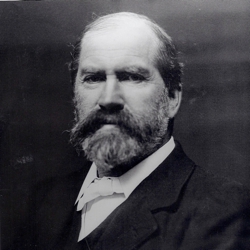Canon Hardwicke Drummond Rawnsley
29 September 1851 – 28 May 1920

The Armitt Museum / www.armitt.com
Vicar, writer, conservationist and campaigner, Canon Hardwicke Rawnsley’s achievements have had a lasting legacy on the Lake District, and the wider UK.
A founding member of the National Trust, he devoted much of his life to ensuring that the natural beauty of the Lake District was persevered for the generations that followed. Today, the National Trust owns over 350 properties of historical interest, and over 950-square miles of land – a testament to Rawnsley’s devotion to preservation.
Biography
Hardwicke Drummond Rawnsley was born in September 1851, the son of Reverend Robert Rawnsley and his wife Catherine, at the rectory in Shiplake, Oxfordshire. He studied natural sciences at Oxford University, where he met John Ruskin. The two would become firm friends and Ruskin’s thoughts and publications concerning conservationism had a profound influence on Rawnsley.
Following in his father’s footsteps, Rawnsley was ordained in 1874, and initially served as a deacon in Bristol, before taking up the position of Vicar of Wray, near Windermere, in 1878. In the same year, he married his wife Edith, and the two would later have one son, Noel. Whilst at Wray, Rawnsley became involved in a number of campaigns regarding the protection of the Lake District countryside, successfully challenging plans to construct railway lines from the quarries in Buttermere. Inspired by his success here, Rawnsley formed the Lake District Defence Society along with his friend John Ruskin and other notable figures. Later, in 1883, Rawnsley moved to Keswick, where he became vicar of Crosthwaite and helped to establish Keswick School. When he was elected to Cumberland County Council in 1888 he was able to secure further protections of the Lake District countryside against development.
In 1895, inspired by Ruskin, Rawnsley co-founded the National Trust. From then he worked as Honorary Secretary to the Trust, and continued his campaign efforts to preserve the countryside. He retired in 1917, and moved to Allan Bank in Grasmere – William Wordsworth’s former home. He died in 1920, leaving Allan Bank to the National Trust.
Legacy
The formation of the Lake District Defence Society in 1883 by Rawnsley was just the beginning of a lifelong effort to secure the natural beauty of the area for future generations. In 1895, inspired by ideas previously put forward by his friend John Ruskin, Rawnsley worked with social reformer Octavia Hill and solicitor Sir Robert Hunter to form the National Trust. The three founders raised funds to buy Brandelhow Woods on Derwent Water on behalf of the Trust, and since that first purchase the Trust has taken on ownership of over 350 historical properties and 950-square miles of land.
Links to the Lake District
Whilst it was Rawnsley’s calling as a vicar that first brought him to the Lake District, there is no doubt that the outstanding beauty of the area and his passionate beliefs concerning conservation held him here, leading him to decline an invitation to become a Bishop in Madagascar in 1898. It is likely that without Rawnsley’s influence, a significant proportion of the National Park’s natural landscapes would be radically different, with additional railway lines, roads, and buildings added by developers.
In 1882, Rawnsley met the young writer Beatrix Potter whilst she visited Wray Castle with her family. It is said that Rawnsley had considerable influence on Potter, encouraging her to publish her first story and informing her on the importance of conservation. The encounter may have seemed insignificant at the time, but it eventually led to Potter leaving her estate to the National Trust following her death – around 4,000 acres in total. Today around a quarter of the Trust’s land is within the Lake District, and most of it is open to the public.
Sites of Interest
The National Trust hold a number of properties in the Lake District that have been either purchased or donated since Rawnsley first formed the charity. These include Allan Bank, former home of Rawnsley and prior to that, William Wordsworth, as well as Wray Castle, where Rawnsley reportedly met Beatrix Potter.
Much of the land around the Lakes is owned by the National Trust and open to the public. Brandelhow Woods, the first piece of land that was purchased by the Trust, is a delightful place to visit for a gentle stroll, and is included in our family friendly walking guide.
